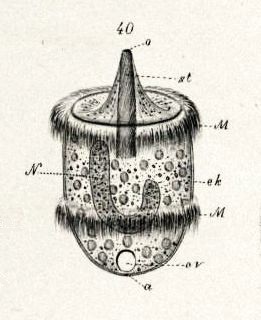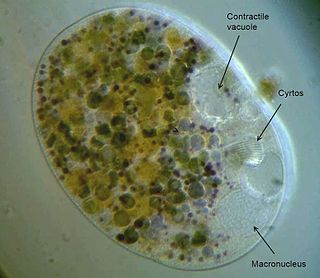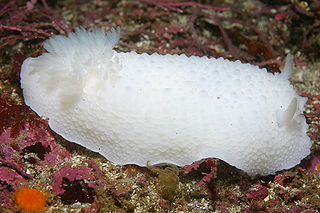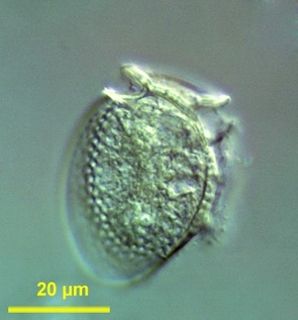| Lacrymaria | |
|---|---|
 | |
| Lacrymaria olor | |
| Scientific classification | |
| Domain: | |
| (unranked): | |
| Phylum: | |
| Class: | |
| Family: | |
| Genus: | Lacrymaria |
| Species | |
See text | |
Lacrymaria is a genus of ciliates. Its best known species is the "Tear of Swan", Lacrymaria olor . [1]
| Lacrymaria | |
|---|---|
 | |
| Lacrymaria olor | |
| Scientific classification | |
| Domain: | |
| (unranked): | |
| Phylum: | |
| Class: | |
| Family: | |
| Genus: | Lacrymaria |
| Species | |
See text | |
Lacrymaria is a genus of ciliates. Its best known species is the "Tear of Swan", Lacrymaria olor . [1]
The genus includes the following species:

Blepharisma is a genus of unicellular ciliate protists found in fresh and salt water. The group includes about 40 accepted species, and many sub-varieties and strains. While species vary considerably in size and shape, most are easily identified by their red or pinkish color, which is caused by granules of the pigment blepharismin.

Didinium is a genus of unicellular ciliates with at least ten accepted species. All are free-living carnivores. Most are found in fresh and brackish water, but three marine species are known. Their diet consists largely of Paramecium, although they will also attack and consume other ciliates. Some species, such as D. gargantua, also feed on non-ciliate protists, including dinoflagellates, cryptomonads, and green algae.

Arcellinid testate amoebae or Arcellinida, Arcellacean or lobose testate amoebae are single-celled protists partially enclosed in a simple test (shell).

Peridinium is a genus of motile, marine and freshwater dinoflagellates. Their morphology is considered typical of the armoured dinoflagellates, and their form is commonly used in diagrams of a dinoflagellate's structure. Peridinium can range from 30 to 70 μm in diameter, and has very thick thecal plates.

Nassula is a genus of unicellular ciliates, belonging to the class Nassophorea. Like other members of the class, Nassula possesses a basket-like feeding apparatus made up of cytopharyngeal rods (nematodesmata), which are themselves composed of closely packed microtubules. Nassula use this structure to ingest filamentous cyanobacteria, drawing individual strands of blue-green algae through the cytopharynx and into the body of the cell, where they are digested. As the algae are broken down, they can take on a variety of bright colours, which give Nassula a distinctive, variegated appearance under the microscope.

Doris is a genus of sea slugs, specifically dorid nudibranchs. These animals are marine gastropod molluscs in the family Dorididae.

Patella is a genus of sea snails with gills, typical true limpets, marine gastropod mollusks in the family Patellidae, the true limpets.

Dinophysis is a genus of dinoflagellates common in tropical, temperate, coastal and oceanic waters. It was first described in 1839 by Christian Gottfried Ehrenberg and George Rayala.

Peranema is a genus of free-living phagotrophic euglenids. There are more than 20 nominal species, varying in size between 8 and 200 micrometers. Peranema cells are gliding flagellates found in freshwater lakes, ponds and ditches, and are often abundant at the bottom of stagnant pools rich in decaying organic material. Although they belong to the class Euglenoidea, and are morphologically similar to the green Euglena, Peranema have no chloroplasts, and do not conduct autotrophy. Instead, they capture live prey, such as yeast, bacteria and other flagellates, consuming them with the help of a rigid feeding apparatus called a "rod-organ." Unlike the green euglenids, they lack both an eyespot (stigma), and the paraflagellar body (photoreceptor) that is normally coupled with that organelle. However, while Peranema lack a localized photoreceptor, they do possess the light-sensitive protein rhodopsin, and respond to changes in light with a characteristic "curling behaviour."

Condylostoma is a genus of unicellular ciliate protists, belonging to the class Heterotrichea.
| Wikimedia Commons has media related to Lacrymaria (Ciliate) . |